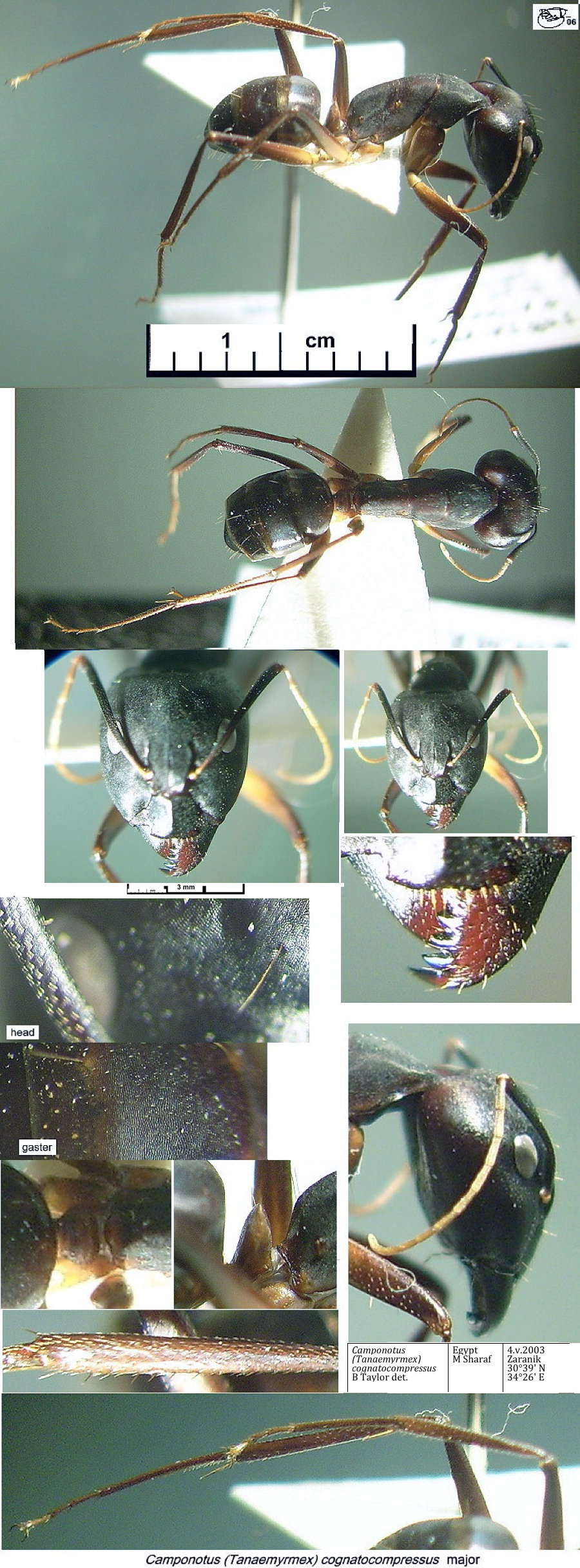Camponotus (Tanaemyrmex) cognatocompressus Forel
  Type locality "Africa"
(Camponotus rubripes Drury r cognatus Sm. var. cognato-compressus,
Forel, 1886f: 143 & 151, "unavailable name"; Forel, 1904b: 379,
worker, queen & male - no images on Antweb (September 2014); probably wrongly synonymized and raised to species under name xerxes,
Pisarski, 1967: 414, see below) Type locality "Africa"
(Camponotus rubripes Drury r cognatus Sm. var. cognato-compressus,
Forel, 1886f: 143 & 151, "unavailable name"; Forel, 1904b: 379,
worker, queen & male - no images on Antweb (September 2014); probably wrongly synonymized and raised to species under name xerxes,
Pisarski, 1967: 414, see below)
all forms described (see Bolton, 1995)  . .
Arguably this and Camponotus xerxes are separate species but without type images of cognatocompressus one cannot be sure.
|
Forel's (1886f) description is at  ; the specimens were
earlier described (under the much smaller Camponotus cognatus) in his (1879a) paper - the
text is at ; the specimens were
earlier described (under the much smaller Camponotus cognatus) in his (1879a) paper - the
text is at  . Forel's (1904f)
description of xerxes is at . Forel's (1904f)
description of xerxes is at  . The overall feature
from Forel's several pieces, is of a form that is larger and matt
relative to maculatus s.s. The specimens were from Egypt and
Tunisia, although I suspect the Forel (1879a) specimens were those
listed by Magretti (1884) from the Sudan-Eritrea border area.
Forel's (1904f) brief note on xerxes gives that as wholly
black, whereas the cognatocompressus from Africa had the
alitrunk and even part of the gaster reddish-yellow. In the earlier
work (1886f) he noted the soldiers were larger TL ca 15 mm) than any Camponotus
maculatus variety. The xerxes type major is similra in TL but has a larger head, both in width and length to the Egypt major shown below. . The overall feature
from Forel's several pieces, is of a form that is larger and matt
relative to maculatus s.s. The specimens were from Egypt and
Tunisia, although I suspect the Forel (1879a) specimens were those
listed by Magretti (1884) from the Sudan-Eritrea border area.
Forel's (1904f) brief note on xerxes gives that as wholly
black, whereas the cognatocompressus from Africa had the
alitrunk and even part of the gaster reddish-yellow. In the earlier
work (1886f) he noted the soldiers were larger TL ca 15 mm) than any Camponotus
maculatus variety. The xerxes type major is similra in TL but has a larger head, both in width and length to the Egypt major shown below.
For comparison, Emery's (1893f) description of Camponotus
adenensis
is at  . Although generally like
"compressus", see Camponotus compressus;
this has relatively shorter scapes, SI 0.85; there are no
"aiguillons" or short setae on the lower margin of the tibiae; the
petiole scale has a rounded upper margin. . Although generally like
"compressus", see Camponotus compressus;
this has relatively shorter scapes, SI 0.85; there are no
"aiguillons" or short setae on the lower margin of the tibiae; the
petiole scale has a rounded upper margin.
|
Oxford University Museum
specimens
Camponotus (Tanaemyrmex) cognatocompressus
B Taylor det.
|
Egypt
M Sharaf
|
4.v.2003
Zaranik
30°39' N
34°26' E
|
no details
|
1
|
 |
Camponotus (Tanaemyrmex) cognatocompressus
B Taylor det. |
Egypt
A Shepherd
|
2010
Sinai
28°33' N
33°56' E
|
St Katherine’s
Protectorate
Large Blue at night
|
2
|
 |
Camponotus (Tanaemyrmex) cognatocompressus
B Taylor det. |
Israel
J Kugler
|
22.iv.1981
Ziqim
|
|
5
|
 |
|
 The photomontage
is of a major worker from Egypt,
Zaranik, N. Sinai; collector Mostafa
Sharaf. The photomontage
is of a major worker from Egypt,
Zaranik, N. Sinai; collector Mostafa
Sharaf.
This has CI 89, distinct setae on lower margin of hind
tibiae,
a sharp summit to the petiole scale.
|
 The
photomontage is of a media worker from Egypt, Sinai, St
Kathsrine's; collector Amy Shepherd. The
photomontage is of a media worker from Egypt, Sinai, St
Kathsrine's; collector Amy Shepherd.
|
 The
photomontage is of a minor worker from Egypt, Sinai, St
Kathsrine's; collector Amy Shepherd. The
photomontage is of a minor worker from Egypt, Sinai, St
Kathsrine's; collector Amy Shepherd.
|
 The photomontage
is of a major worker from Israel; collector J Kugler. The photomontage
is of a major worker from Israel; collector J Kugler.
|
|